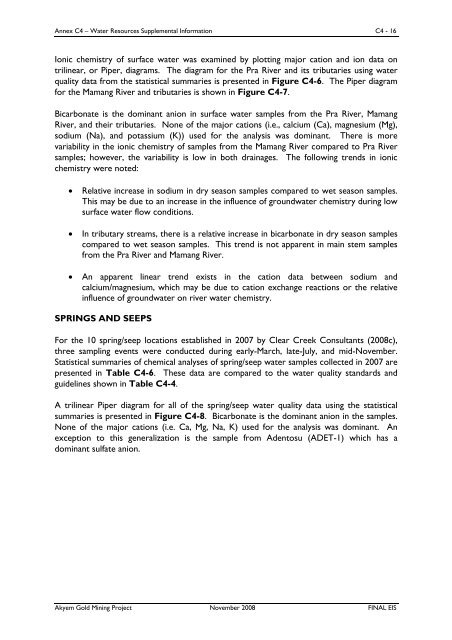annexc - Newmont Mining Corporation
annexc - Newmont Mining Corporation
annexc - Newmont Mining Corporation
Create successful ePaper yourself
Turn your PDF publications into a flip-book with our unique Google optimized e-Paper software.
Annex C4 – Water Resources Supplemental Information C4 - 16<br />
Ionic chemistry of surface water was examined by plotting major cation and ion data on<br />
trilinear, or Piper, diagrams. The diagram for the Pra River and its tributaries using water<br />
quality data from the statistical summaries is presented in Figure C4-6. The Piper diagram<br />
for the Mamang River and tributaries is shown in Figure C4-7.<br />
Bicarbonate is the dominant anion in surface water samples from the Pra River, Mamang<br />
River, and their tributaries. None of the major cations (i.e., calcium (Ca), magnesium (Mg),<br />
sodium (Na), and potassium (K)) used for the analysis was dominant. There is more<br />
variability in the ionic chemistry of samples from the Mamang River compared to Pra River<br />
samples; however, the variability is low in both drainages. The following trends in ionic<br />
chemistry were noted:<br />
• Relative increase in sodium in dry season samples compared to wet season samples.<br />
This may be due to an increase in the influence of groundwater chemistry during low<br />
surface water flow conditions.<br />
• In tributary streams, there is a relative increase in bicarbonate in dry season samples<br />
compared to wet season samples. This trend is not apparent in main stem samples<br />
from the Pra River and Mamang River.<br />
• An apparent linear trend exists in the cation data between sodium and<br />
calcium/magnesium, which may be due to cation exchange reactions or the relative<br />
influence of groundwater on river water chemistry.<br />
SPRINGS AND SEEPS<br />
For the 10 spring/seep locations established in 2007 by Clear Creek Consultants (2008c),<br />
three sampling events were conducted during early-March, late-July, and mid-November.<br />
Statistical summaries of chemical analyses of spring/seep water samples collected in 2007 are<br />
presented in Table C4-6. These data are compared to the water quality standards and<br />
guidelines shown in Table C4-4.<br />
A trilinear Piper diagram for all of the spring/seep water quality data using the statistical<br />
summaries is presented in Figure C4-8. Bicarbonate is the dominant anion in the samples.<br />
None of the major cations (i.e. Ca, Mg, Na, K) used for the analysis was dominant. An<br />
exception to this generalization is the sample from Adentosu (ADET-1) which has a<br />
dominant sulfate anion.<br />
Akyem Gold <strong>Mining</strong> Project November 2008 FINAL EIS











